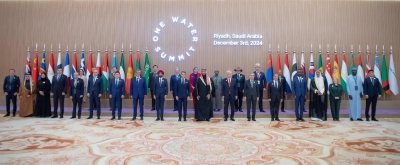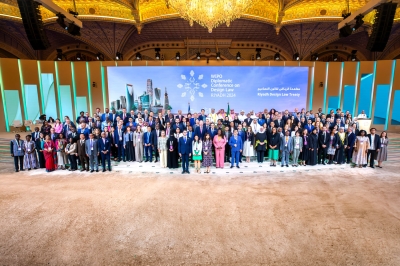
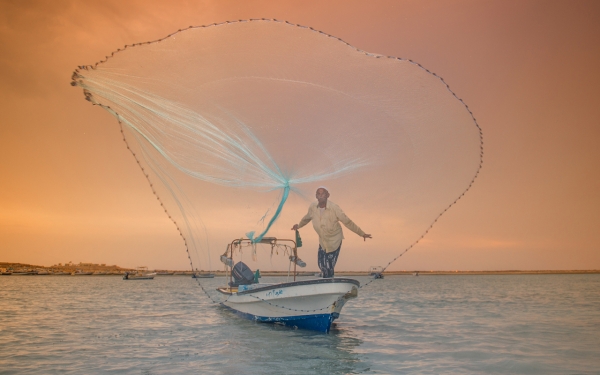
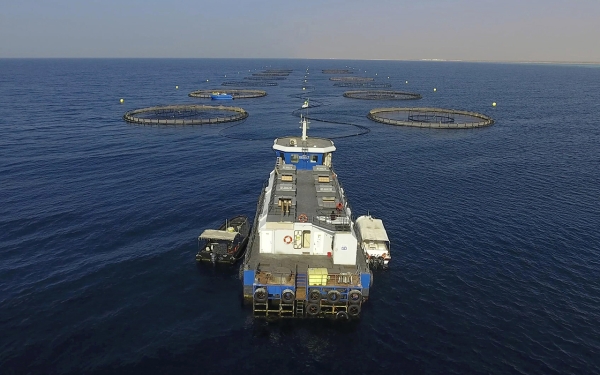
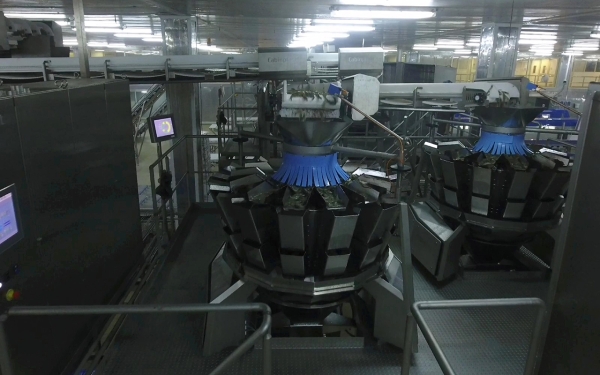
Fishing and Aquaculture in the Kingdom involve the development of the two types of aquatic products: aquaculture and marine fisheries to achieve self-sufficiency in fishery resources, meet Saudi Arabia's seafood needs, diversify sources of income, and support the economy.
Saudi Arabia's fisheries sector is one of the best biosecurity sectors worldwide. Net national seafood production reached around 140,000 t in 2020, with a consumption volume of 295,000 t, and 55 percent self-sufficiency in food security. Imports reached 215,000 t, while domestic aquaculture production was around 80,000 t, with export volumes of 60,000 t. In 2020, the local production of fisheries reached about 60,000 t.
Aquaculture in Saudi Arabia
Aquaculture in Saudi Arabia began with the establishment of the Fishery Resources Research Center in Jeddah in 1982. The objective was to study local fish species suitable for aquaculture and provide technical and advisory support for emerging aquatic farms.
Fish aquaculture is one of the fastest-growing food sectors, with an annual growth rate of 6 percent. The Ministry of Environment, Water, and Agriculture (MEWA) seeks to raise the productive and marketing efficiency of aquaculture by supporting the establishment of a newly formed entity comprising existing small-scale aquaculture projects. The total amount of fish harvested from marine fisheries and aquaculture in 2021 was around 177,264 t.
Saudi Arabia is rich in natural resources along its 2,600 km coastline and has a capacity of five million t of fish. It is recognized worldwide for its quality, which is consistent with international biosecurity standards. It seeks to ensure that all companies working in the sector are certified with Best Aquaculture Practices (BAP).
Saudi Arabia's aquaculture sector features a diverse range of aquatic species, such as shrimp, sea fish, freshwater fish, and sea algae. The approved fisheries projects include thirteen saltwater fish farms, six shrimp farms, 136 inland water fish farms, and one farm dedicated to aquarium fish.
Based on the 2019 MEWA statistics, the annual production capacity of saltwater fish farms is 5,367.095 t and three million fish in aquarium fish farms. Moreover, the annual production capacity of inland water fish farms is 9,217 t, and 60,745.959 t for shrimp farms.
The Saudi Aquaculture Society is working with the ministry's Directorate of Fishery Resources to enact the necessary regulations, legislation and plans to ensure the success and growth of the fish aquaculture industry in Saudi Arabia. They are also preparing the aquaculture industry, conducting environmental studies, following up on environmental compliance of projects, and motivating commercial entities to make suitable investments.
Cultured fish in Saudi Arabia
Shrimp is one of the most important cultured species in Saudi Arabia. They are available in two types: Ghanimi Shrimp, which entered Saudi Arabia in 2012, and White Indian Shrimp, which was first cultured when the first commercial farm dedicated to fish culturing was established in 1997. In 2000, the National Aquaculture Company was founded, and it is considered the largest producer of white shrimp in the world.
Sea fish are also among the cultured species in Saudi Arabia. They consist of several species, including Barramundi fish cultured in 1998; Guilt-Headed Bream, which entered Saudi Arabia in 2008; Sparidae; Grouper; Spinefoot; Tilapia Sea fish; mullet and sturgeons.
Inland aquaculture in Saudi Arabia
Freshwater fish are the most important species cultured in inland water farms. They are distributed in several regions, such as Riyadh, Qassim, Hail, the Eastern Province, and Makkah. The Nile tilapia constitutes the largest production volume at 98 percent. These farms also produce other fish species, such as aquarium fish and caviar.
Sea cucumbers are newly cultivated species in Saudi Arabia, as they were grown in 2013 with an annual production of about 90 t. Moreover, various types of marine algae are being cultivated, such as microalgae.
Projects and programs to develop aquaculture in Saudi Arabia
The National Aquaculture Group (NAQUA) is among the world's largest marine farms in the world that specialize in shrimp and fish production. It receives funding from the Agricultural Development Fund. It produces around one hundred thousand t of seafood products and exports shrimp, fish, and sea cucumber to about thirty-two countries, including Japan, Korea, China, Australia, and the United States.
The National Biosecurity Monitoring Program covers production stages to make sure that cultured aquatic species and their products are free of pathogens and ensure that measures are in place to protect the projects. The program handles several tasks, including preventing diseases, improving the health of cultivated organisms, reducing disease spread, and increasing project profitability.
The program's 2018 statistics indicate that more than twenty-two thousand samples were taken. The number of shrimp samples had reached 13,349, while 7,136 fish samples were collected, alongside 1,423 lobster samples and 164 plankton samples. The five main sample areas include: Madinah, Tabuk, Makkah, Jazan, and the Eastern Province.
Marine fisheries in Saudi Arabia
Marine fisheries are one of the fishing profession's sectors. The Directorate of Fishery Resources supervises all matters related to fishermen, fishing instruments, permits for maritime excursions, used fishing tools, fishing ports, and disembarkation points.
According to the directorate, Saudi Arabia's fisheries in the Red Sea and the Arabian Gulf produce around seventy thousand t of fish. The production of the Arabian Gulf equals 63 percent of the production volume with more than 44,500 t produced annually, while the Red Sea's production constitutes 63 percent of the production volume with around 26,500 t per year.
Between 2012 and 2021, the number of fishing boats in the Arabian Gulf reached 2,133, in addition to 8,475 traditional boats in the Red Sea and 156 industrial ones, with a total of 10,764 boats. According to the 2021 MEWA statistics, the number of fishing manpower reached 30,019, including 8,746 fishermen and 3,700 Saudi fishing workers.
Saudi Arabia houses thirteen fishing ports, four under construction ones, and 150 outlets for selling fish. Moreover, MEWA maintains the stability of selling prices.
To enhance the productivity and marketing efficiency of the fishing sector, the fish quality label SAMAQ, a national certification system for aquaculture certifications and product labelling, was launched in 2018.
Related quizzes
Related articles
